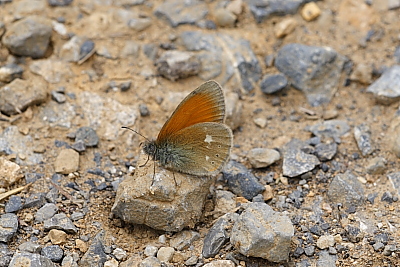
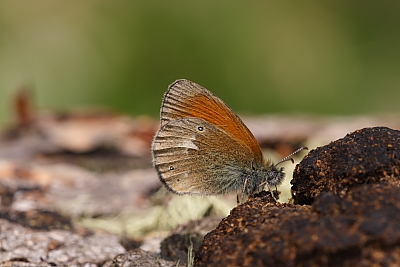
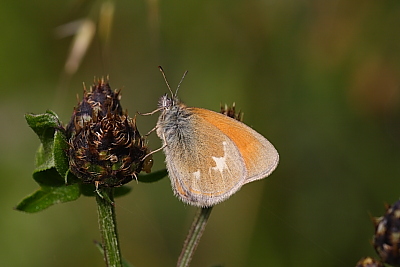
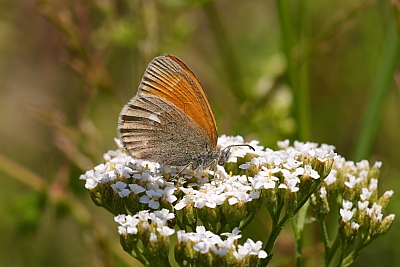
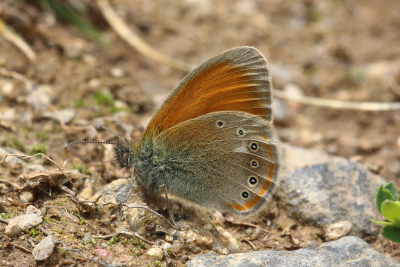
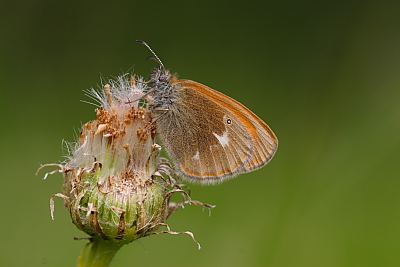
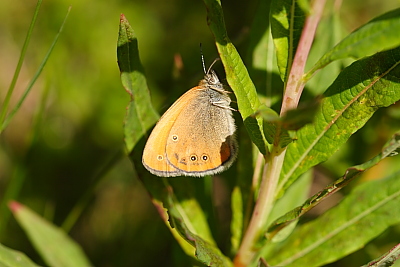
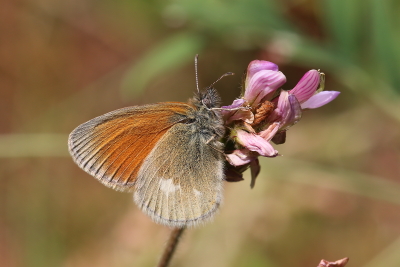
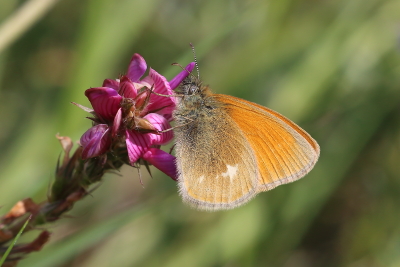
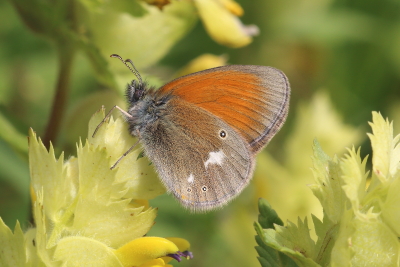
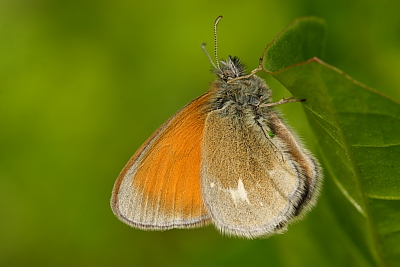
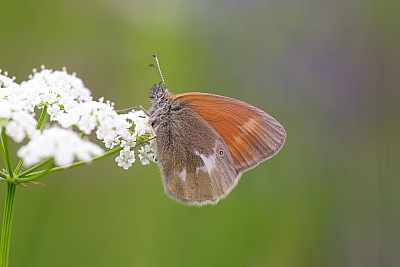
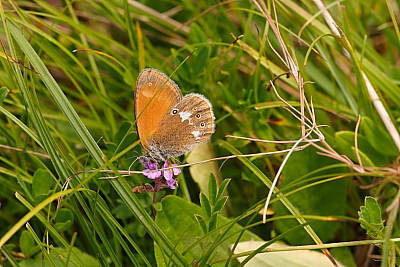
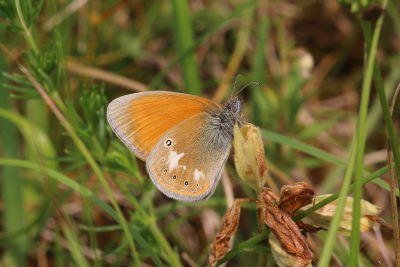
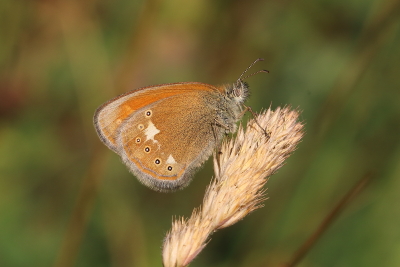
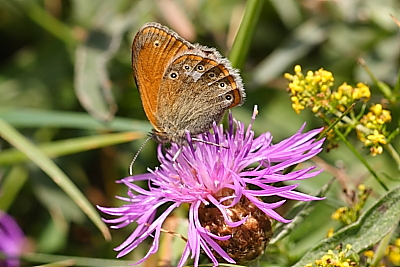
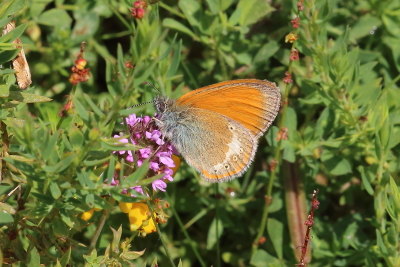
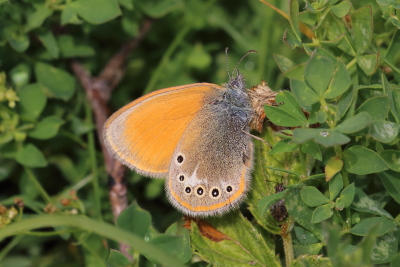
48364_sex?_Pyrénées-Orientales_12Jul21
Chestnut Heath (Coenonympha glycerion)
2024 photographs highlighted in yellow. Click on any photograph to go to an enlarged picture, or simply scroll down the page.
|
This is a very widespread species, encountered at most high altitude locations, even though it is not exclusively a high altitude species. It is usually found in good numbers, but not often common at any location.
There seems to me to be an amazing variation between individuals, even within the same locality, from strong unh ocelli to none at all, as well as variation in colouration - in fact the majority of individuals could not be described as chestnut. The male has a darker unf and smaller unh white markings. The books usually say that glycerion can be identified by the series of unh post-discal spots with brilliant white pupils. However, this is somewhat unhelpful given that the form bertolis, which has no ocelli at all, is not uncommon at high altitudes. Surprisingly, H&R makes no reference to bertolis.
Lafranchis in TLID quotes the identifier for glycerion as being the pale orange marginal line on the unh. This is patently misleading, as can be seen from the various specimens on this page. Whilst it may be true for lowland individuals, the higher altitude specimens here show a range from no orange line at all, to a line that is probably quite weak at best. |
There is a very similar species of perhaps indeterminate taxonomical status, the Spanish Heath (C. iphioides), which flies in northern Spain and does not occur in France. In H&R it is classified as a separate species although in the later T&L it is classified as a subspecies of glycerion. There is also some uncertainty relating to the taxonomic status of the populations that occur on the French side of the Pyrénées (see 38647 below); on the glycerion page of the Lepinet web site (www.lepinet.fr) it states (and my translation may not be totally accurate): "The status of the French populations of the eastern Pyrénées was the subject of a recent study (Mazel & De Gregorio, 2015) suggesting that these populations constitute a third taxon to be considered a separate species: C. pseudoamyntas (Sagarra 1930) of hybrid origin. The study found that all populations of the French Pyrénées could therefore be considered as pseudoamyntas while iphioides would be considered to be restricted to the Iberian Peninsula." . Glycerion could be confused with the Large Heath (C. tullia), especially if the unh has significant ocelli; the differences are addressed on the tullia page. |
| ref | sex |
observations |
alt. m |
| 21713 | M |
a very dark male, with an appealing deep chestnut colouring. |
1400 |
| 21847 | M |
another strongly chestnut coloured male, with a large unh ocellus in s6 c.f. 21713's three small ocelli, and nothing in s6. |
1600 |
| 21890 | M |
a paler male, with not a hint of an ocellus. It is the form bertolis. |
1750 |
| 26631 | M | a dark male of the form bertolis. | 1400 |
| 51223 | M | a male, from the border region between France and Spain, just on the French side. Like 48364 and 38647, it is either Spanish Heath (C. iphioides) or, at least, transitional and very close to it. | 1820 |
| 26682 | ? | a delicately marked glycerion, with only a vestigial unh ocellus in s2 and a stronger one in s6. An interesting submarginal unh band of warm chestnut colour. | 2000 |
| 7261 | ? |
this rather strange specimen has a very strong but pale chestnut colouring especially on the unf and the unh marginal band, with no white unh post-discal mark, and no ocellus at all in s1 or s5. I am rather surprised to find glycerion as strongly coloured as this (and 7261 is the most orange specimen I have seen) at such high altitude. |
2100 |
| 41563 | ? | a very nice chestnut-brown colouring on this bertolis individual. | 2020 |
| 41575 | ? | a much lighter orange-brown colouring, despite it being seen at the same location and on the same day as 41563. | 2020 |
| 41819 | ? | a chestnut-brown individual, seen in Savoie, further north in the French Alpes than the Hautes-Alpes. It has three ocelli of varying sizes, so could be considered as intermediate between the nominate form and bertolis. | 2060 |
| 11981 | ? |
a typical example of the altitude form bertolis with no ocelli. |
1580 |
| 21805 | F |
a female, which only know because I saw it in flight and the orange forewings of the female were clearly visible (the forewings of the male are noticeably darker). A mid-chestnut colour and a significant ocellus in s6 and a vestigial one in s2. |
1600 |
| 34040 | ? | whereas most of the glycerion on this page have little or no unh ocelli, this is rather different. This fits well with bertolis being the high altitude form, as 34040 is a lowland individual and a close match with the nominate form. | 430 |
| 43007 | ? | a very typical glycerion. | 430 |
| 44495 | ? | a rather darker individual, with what appears to be rather elongated hindwing shape. It has a regular series of unh ocelli of consistent size. | 1550 |
| 38647 | F | this rather poor shot was taken in the Pyrénées, just on the French side. It almost exactly matches the T&L illustration for Spanish Heath (C. iphioides) which allegedly does not occur in France and according to Lafranchis does not even occur in the border region of France. Lafranchis quotes the strong unh orange border as being characteristic of iphioides. It is probably the separate species or subspecies known as pseudoamyntas (see narrative above). | 1820 |
| 48340 | ? | another specimen from the same location as 38647 above, but with greatly reduced ocelli. | 1820 |
| 48364 | ? | also from the same location, this very closely matches the illustration of iphioides in T&L. The ocelli are exceptionally well-developed and yellow-ringed. I find it hard to believe that this is not, in fact, iphioides, or, at least, transitional and very close to it. | 1820 |
21713_male_Alpes-Maritimes_7Jul10
21847_male_Alpes-Maritimes_9Jul10
21890_male_Hautes-Alpes_11Jul10
26631_male_Alpes-Maritimes_08Jul11
51223_male_Pyrénées-Orientales_5Jul23
26682_sex?_Alpes-Maritimes_09Jul11
7261_sex?_Alpes-Maritimes_24Jun07
41563_sex?_Hautes-Alpes_15Jul16
41575_sex?_Hautes-Alpes_15Jul16
41819_sex?_Savoie_42572_21Jul16
11981_sex?_Alpes-de-Haute-Provence_5Jul08
21805_female_Alpes-Maritimes_8Jul10
44495_sex?_Alpes-Maritimes_17Jul17
38647_female?_Pyrénées-Orientales_17Jul15
48340_sex?_Pyrénées-Orientales_12Jul21
48364_sex?_Pyrénées-Orientales_12Jul21